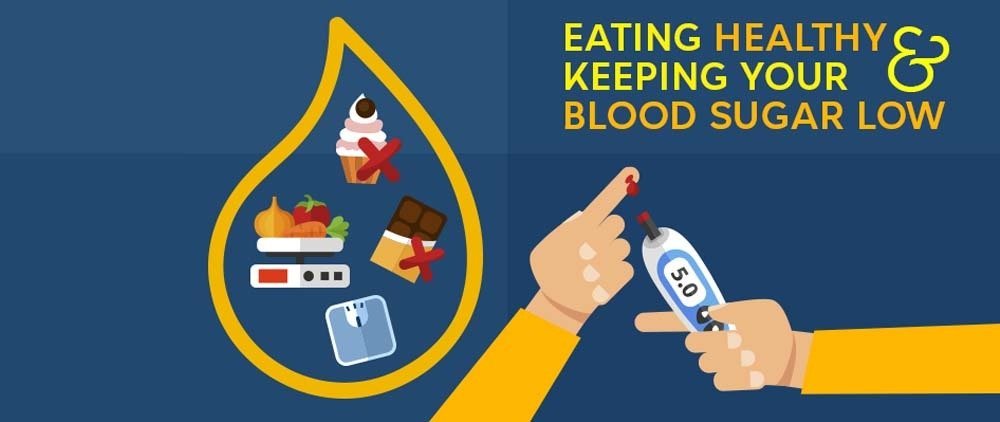Contents:
Modern humans and the perils of our age
What is diabetes?
Control your weight
What to eat
Sweat it out!
Conclusion
Modern humans and the perils of our age
Throughout history and up until very recently, we humans haven’t paid much attention to our diet. When we were hungry, food gave us the energy to endure strenuous physical activity. For millennia we have been hunting in the bush, toiling on farms, cutting down trees, and rowing in boats; all of which required tremendous amounts of energy and consequently a lot of high-calorie foods. In its essence, eating is converting mass into energy to fuel our bodies. A nice juicy steak would give a lumberjack the energy to work for an entire day, and burgers at lunch are almost a must for those working in construction. However, our world is changing before our eyes so rapidly that we are often slow to react. More and more of us spend our working hours sitting in an office typing away on a computer, but we still crave the same food our parents and grandparents loved. Generally, we don’t need as much energy as they did and we simply can’t burn off the calories from a juicy steak by typing on a laptop. Thus modern life itself gives rise to new problems, most of which we had little knowledge of before. One such new epidemic is diabetes, which affects millions and costs the nations of the world billions of dollars each year.
According to the study “Economic Costs of Diabetes” by the American Diabetes Association, more than 29 million Americans have diabetes; of those, about 6 million don’t know they have the disease. In 2007, diabetes cost the U.S. an estimated $116 billion in excess medical spending and an additional $58 billion in reduced productivity. The problem of diabetes is most pronounced in the Western world, but as the world economy continues to shift this will become a much bigger problem worldwide. That being said, the story isn’t quite as bleak as one may think. Rather, there are a few simple steps that we can take to keep our blood sugar under control. First and foremost, we will delve into the intricacies of the human body and quickly establish what diabetes actually is.
What is diabetes?
The human body is made up of tiny cells, which need one substance most of all to keep the great machine that is the human body operating, that substance is glucose. Most carbohydrates that we consume are quickly transformed into glucose and absorbed into the bloodstream. When glucose levels rise too high, the pancreas goes into action and releases insulin, which instructs cells to absorb the excess sugar floating around in the cardiovascular system. This hormone is the key, when there isn’t enough insulin or cells don’t react to its stimuli, sugar levels soar and diabetes develops.
There are two types of diabetes. Type one occurs when the immune system treats insulin-producing cells as hostiles and attacks them, permanently destroying them. This leaves the body without natural means to control blood sugar levels. Merely 5-10% of diagnosed cases of diabetes fall into this category.
Type 2 diabetes is far more prevalent and can take years to develop. It boils down to cells no longer responding to insulin’s signal. As a result, the pancreas increases the production of insulin, and eventually, insulin-producing cells begin to collapse from overexertion.
American Diabetes Association. Pre-diabetes is a condition attributed to high glucose levels on a glucose tolerance test. But there is no need to panic, with the right diet and regular exercise not only can we prevent pre-diabetes from developing diabetes, but we can return our blood sugar to normal levels. Now let’s get to it!
Control your weight
If we want to prevent high blood sugar, maintaining a slim and fit physique is the way to go. Of course, this doesn’t mean that we must all be supermodels, nor that all fat is equally bad. Fat concentrated around the thighs and posteriorly isn’t as problematic as belly fat. The fat that gathers around the stomach surrounds digestive organs and acts as a protective shield against insulin, so the concentration of fat in the abdominal region generally increases the likelihood of developing diabetes. To be more specific, a woman with a waist circumference of 35 inches or more, or a man with a waist circumference of 40 inches or more will have an increased risk of developing diabetes. In such cases losing weight is crucial, in fact losing just 5-10% of body weight can be extremely helpful in reducing blood sugar, blood pressure, and cholesterol levels.
Now we move on to the most important bit: how exactly can we quickly lose weight and lower our blood sugar levels?
What to eat?
The first step, of course, is to plan our diet. Let’s start by answering the first logical question: “should I relinquish sweets?” The simple answer is no. You should lower your intake, but there is no need to relieve yourself of sugary delights for good. The danger lies in other foods, foods we rarely think of as sugar-inducing. The key here is what’s known as the glycemic index (GI); this measures how quickly a particular food increases blood sugar levels. High GI foods can cause upticks in blood sugar levels. Foods whose carbohydrates break down quickly during digestion and release glucose rapidly are high on the GI scale. The opposite is true for low-GI foods. So, a balanced diet of healthy fats, lean proteins, vegetables, and high-fiber carbs is the way to go. What delicious foods satisfy these criteria?
Your first pick should be whole-grain carbohydrates, as these are rich in minerals, vitamins, and fiber. Also, they are slow to break down and serve as an excellent source of energy. These include legumes, beans, wild or brown rice, quinoa, amaranth, millet, whole-grain pasta, cereals, and bread. On the other hand: white bread, white rice, mashed potatoes, donuts, bagels, and many breakfast bowls of cereal are high on the GI scale and should be avoided by anyone with high blood sugar.
Previously we mentioned good and bad body fat, there are also good and bad fats that you can ingest. Monounsaturated and polyunsaturated fats are considered good fats. Foods that are high in sodium, saturated fats, trans fats, and cholesterol are the bad ones. This means more olive oil, fish, and nuts while reducing the intake of red meats and dairy products will do wonders to reduce levels of undesirable fats.
Of course, we want to eat more fruits and veggies, especially those that are rich in fiber and carbs. These include blueberries, raspberries, pears, cherries, apples, broccoli, spinach, tomatoes, cabbage, etc. In a Finnish study, men who ate the most apples and other foods high in quercetin had 20% fewer diabetes and heart disease-related deaths. Other good sources of quercetin are onions, tomatoes, leafy green vegetables, and berries. Cinnamon can also be beneficial. A study at the Human Nutrition Research Center in Beltsville, Maryland, found that if you consume half a teaspoon of cinnamon daily it can make cells more sensitive to insulin. If you fear that drinking beer or wine is contributing heavily, there is no need to worry. Moderate amounts of alcohol—up to a drink a day for women and two drinks a day for men—can increase the efficiency of insulin in delivering glucose to cells. Now that we have covered the eating piece, we move on to exercise.
Sweat it out!
Exercising your muscles helps them to utilize insulin and absorb glucose effectively. This doesn’t mean that you have to exercise like a professional athlete; rather a small amount of exercise can go a long way toward reducing blood sugar levels. Findings from the Nurses’ Health Study and Health Professionals Follow-up Study suggest that walking briskly for a half hour every day reduces the risk of developing type 2 diabetes by 30%. Additionally, if you intend to develop muscle mass quickly, you may consider using supplements. For men a testosterone booster can speed up muscle buildup considerably, decreasing the likelihood of developing high blood sugar. Essentially, you just need to work up a good sweat, nothing fancy. Half an hour per day of jogging, swimming, or cycling would be ideal. Spend less time in front of the TV or computer if at all possible.
That’s about it, a bit of sweat, being a bit pickier with your food, and voila! – You are on a path to a much healthier lifestyle. Now close your laptop, drop your smartphone, go for a run, or grab a snack as a human of the 21st century!



